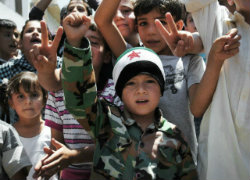As many, if not all of you, know, the conflict in Syria continues to rage on, affecting thousands in Syria and the surrounding areas. What started out as a desire to move towards democracy in a peaceful fashion has turned into a bloody and unrelenting war that only continues to get worse. In fact, the Syrian government has recently been accused of using chemical weapons in its attacks against rebels causing dire effects on the local population. However, amongst all the atrocities one tends to forget or overlook the most devastated victims of this two-year conflict: the Syrian children.

(HuffPo)
During all times of war, children usually bear the brunt of the negative consequences. The conflict in Syria has been no exception. The Save the Children foundation recently released a report that claims nearly two million children in Syria are currently endangered by the ongoing conflict. More than 500,000 of those currently affected in Syria are under the age of 5. Access to basic healthcare and education has also been severely limited, threatening the futures of these children. Furthermore, dismal living conditions have led to widespread disease and hunger among these children without a steady source of help to turn to. With at least 1 of every 5 schools in Syria destroyed, homes in ruins, and shelters quickly filling to capacity, it is not hard to see that hope for these children and the situation in general is dwindling.
The consequences are not simply physical, either. The Save the Children report notes at least 3 in 4 children have experienced death of a close friend or relative, leading to startling psychological consequences, such as extreme withdrawn or aggressive behavior. Furthermore, these children are being forced to endure other atrocities such as sexual violence, torture, and forced recruitment into the armed forces. This is only antagonized by the fact that many of these children have been displaced from their homes, separated from their families, and forced to find refuge in neighboring countries. How can one expect these children to lead a decent, semi-normal life when they are constantly exposed to these horrors?
Many of the countries that are taking in these refugees are struggling with the task. Jordan, a refuge for more than a half million Syrians, has recently been forced to open up a second refugee camp in Mrajeeb al-Fhood as the influx of Syrian refugees into the country continues to grow everyday. This means it might be even more difficult for the refugees, especially children, to get access to basic resources. While Jordan is actually able to provide these refugees with shelter, other countries lack the resources to do so. Currently, there are no UN-funded refugee camps in Lebanon, where some 400,000 Syrian refugees have fled. Adding to their suffering, these refugees must fear for their relatives still living in Syria, as their act of leaving the war-torn country has put them at great risk of execution and torture by the government. Many children, who escaped to the safety of countries such as Egypt or Iraq, will most likely never see their families who are still trapped inside Syria again.
Not all hope is lost, however. The sobering realities described above have prompted generous action. Governments of various nations have pledged funds to help child refugees who have been forced into surrounding countries. Recently, the government of Japan contributed $1.5 million to the United Nation Children’s Fund (UNICEF) to help the child refugees in Iraq. This money will go to basic sanitation, healthcare and education services. Also, the Mrajeeb al-Fhood refugee camp mentioned above is funded by the United Arab Emirates. Furthermore, the UN itself has taken extraordinary measures to ensure that the Syrian child refugees receive basic amenities. The World Food Programme (WFP), a project recently launched by the UN, provides refugee children with meals that support good nutrition and health. Along with the meals, the WFP has also set up programs to encourage children to continue their education, though they are displaced and have suffered much hardship.
The aid currently being provided is a promising start to providing hope for these children. However, not enough is being done. While many countries are making valiant efforts to help these children, UNICEF warns that those currently trapped in Syria are in danger of becoming a “lost generation,” as there is a severe lack of funding. Key agencies and life-saving aid may have to be halted, leaving those children in and around Syria without any help. UNICEF notes that it might not be able to provide Syrian children and their families with clean drinking water in the near future. The conflict seems so far away in our minds; however, we must remember those who have lost their futures because of this senseless violence.
If you would like to donate to the cause of these children, please visit this link: http://www.unicef.org.uk/landing-pages/donate-syria/.
Bailey Woods is a 2L and a Candidacy Editor on the Denver Journal of International Law & Policy

